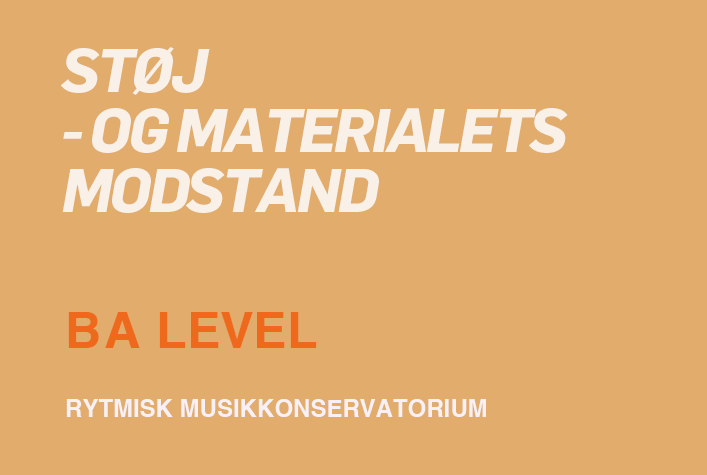
Noise – and resistance in the material
(course will be held in Danish)
Teacher: Jakob Weigand Goetz
Contact: Morten Tandrup, mta@rmc.dk
All music is an expression of the time that it comes from. It bears with it it’s own codes in the shape of opposition / noise / friction / resistance. Some music is filled with resistance, while other music has very little of it.
During this module we will:
*explore what resistance in the material means and what it takes for it to create surplus value in relation to the creation itself. We will be starting off in the five parameters of music: MELODY, HARMONY, RING, RHYTHM and FORM and take a look at how composers, songwriters and producers have at different times created resistance in these parameters.
* Review the positions of the music thinkers from the Enlightenment period and compare their statements with modern art theories in relation to the possible role of music in today’s society. Based on Solvej Balle: “The Art of the Impossible” (2005), we also look at the possibilities of art and music in modern society.
* Focus on RING, SOUND AND NOISE, which for the past 70 years has been a central means of expression in score music, rock, electronica and sound art. Based on sonorous masterpieces by György Ligeti, Jimi Hendrix, My Bloody Valentine, Oval/So and Alva Noto as well as completely newly composed tracks, e.g. Kim Gordon, Tim Hecker, Jon Hopkins and Hanna Hartman (as well as input from the class), we will have a recurring and open discussion of what resistance is embedded in today’s society and how it is reflected in current works.
PREREQUISITES
- Interest in and curiosity towards auditive analysis
- Interest in and curiosity towards the influence points of music
- Experience with composing, arranging and/or producing music is a plus for the general yield of the course
LEARNING OUTCOMES
By the end of the module, the student will:
- have acquired knowledge of the musical parameters and their mutual affinity in terms of analysis
- have knowledge of various European art and music theories 1750-2021
- have acquired knowledge of the aesthetic positions of the different genres and the use of resistance in the material
- be able to employ an analytical approach to be able to produce constructive resistance in the material
CONTENTS
We will work with the following areas:
Melody, harmony, ring (including sound and noise), rhythm, form, musical aesthetics, music psychology, music sociology and comparative analyses in regards to resistance in literature and visual arts.
TEACHING AND WORKING METHODS
– Lectures
– Student presentations
– Debates
– Practical exercises
GROUP FORMATION
Normally 8-9 students per class.
ASSESSMENT
A topic of the student’s choice will be presented within the framework of the themes of the module in the form of an essay (5 standard pages).
The essay is turned in through Wiseflow before the deadline that is set by the Study Administration.
REFERENCES
– Györgi Ligeti: Apparitions, Articulation, Atmosphères, Lontano
– Knut Nystedt: Immortal Bach
– My Bloody Valentine: Come In Alone, To Here Knows When, In Another Way
– Oval: Szenariodisc2 + ovalprocess 0.4, 0.8, 11.1, 11,2
Together we will select all new tracks to be parametrically analyzed, such as:
– Tim Hecker: Radio Spiricom, Azure Azure, Black Refraction, Phantom On a Pedestal
– Jon Hopkins: Abandon Window, Collider, Form By Firelight, Singularity
– Hanna Hartman: Att fälla grova träd är förknippat med risker
Kim Gordon: Sketch Artist, Air BnB
TIME
One bachelor semester. Probably Fridays (not scheduled yet).
PLACE
Rytmisk Musikkonservatorium
ONLINE
No
LEVEL
BA-level
ECTS
2,5
LANGUAGE
Danish
REGISTRATION
If you wish to participate in one of the TVAERS courses, you need to register 1 or 2-course requests.
Before the course start, you will be notified if you can be offered a place on a module.
Registration opens on June 3rd.
The deadline for registration for the fall semester of 2022 is 17 June
You register by this link